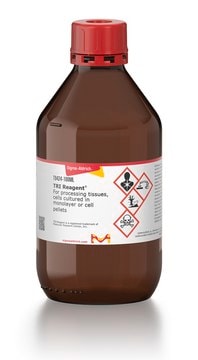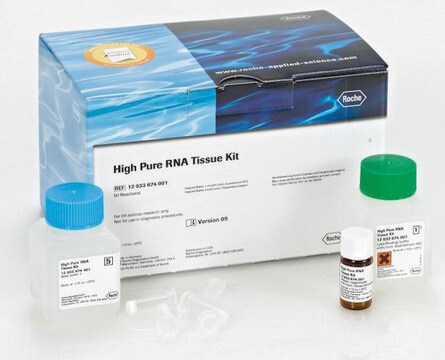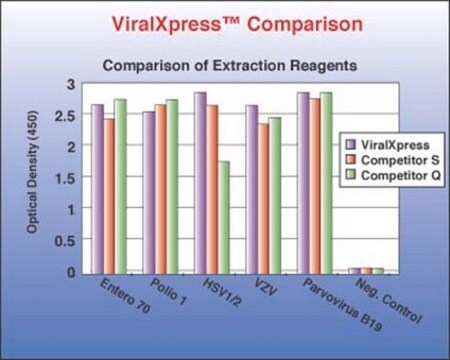Recommended Products
manufacturer/tradename
Chemicon®
EX-WAX
Quality Level
technique(s)
DNA extraction: suitable
application(s)
sample preparation
shipped in
ambient
General description
Limitations:
The quality of extracted DNA is directly related to the quality of the embedded tissue. Harsh or extended fixation will adversely affect the results.
Summary and Principle
The EX-WAX DNA Extraction Kit is qualified on paraffin-embedded mammalian tissues fixed in 10% Formalin or non-crosslinking fixative. DNA is made accessible by protein digestion. DNA is solubilized, while digested proteins are "salted out" and spun to the bottom of the tube. DNA is precipitated, dried under vacuum, and resuspended. Once in solution, the DNA is suitable for amplification by PCR.
Warnings and Precautions
1. Wear gloves when isolating and handling DNA to minimize the activity of endogenous nucleases. Use autoclaved pipette tips and 1.5 ml microcentrifuge tubes for additional protection against nucleases.
2. Volumes are optimized for five 5 μm thick sections.
3. Qualified on tissue fixed in 10% Formalin or non-crosslinking fixative.
4. Not recommended for use with fresh, frozen tissues.
Application
Protein Digesting Enzyme Solution
Add 1.25 ml of Sterile Distilled Water (supplied) to the vial of Protein Digesting Enzyme powder. Mix thoroughly. Store unused solution at -15°C to -25°C.
Extraction Procedure
1. Cut the tissue sections 5 μm thick. Use 3-5 sections for each extraction.
2. Cut away excess paraffin and place sections in a 1.5 ml tube. Spin briefly to pellet sections.
3. Add 1 ml of fresh 100% ethanol (room temperature) and gently vortex for 15 seconds.
4. Spin for 3 minutes in a microcentrifuge at 12,000 rpm.
5. Remove ethanol and dry pellet in a vacuum concentrator or at 60°C for 10 minutes with the cap open. If residual ethanol is still present, dry for another 10 minutes.
6. Add 150 μl of Digestion Solution and 50 μl of Protein Digesting Enzyme Solution to the tube and mix by stirring. Use the end of the micropipettor tip and physically mix the pellet into the solution. Do not pipette up and down (pellet will not dissolve).
7. Incubate for 4 hours to overnight at 50°C.
8. Add 100 μl of Extraction Solution and mix by inversion (at least 3 times) for 15 seconds. Over-mixing will excessively shear the DNA.
9. Spin in a microcentrifuge for 10 minutes at 12,000 rpm. Remove the supernatant and place it in a fresh 1.5 ml tube. This is accomplished by carefully poking the pipette tip through the paraffin layer on top and withdrawing the supernatant, leaving the paraffin and the pellet behind (see Figure 1). If small amounts of paraffin are removed with the supernatant, they will not affect the extraction.
10. Add 150 μl of Precipitation Solution to the supernatant, invert the tube 3 times, then add 900 μl of ice cold (-20°C) 100% ethanol. Cap the tube and invert several times to mix.
11. Place at -20°C for at least 1 hour.
12. Spin in a microcentrifuge for 10 minutes at 12,000 rpm. Discard the supernatant.
13. Dry the pellet in a vacuum concentrator or at 60°C with the cap open for 10 minutes. If residual ethanol is still present, dry for another 10 minutes.
14. Add 50 μl of Resuspension Solution and incubate for 1 hour at 50°C in a water bath.
15. Use 1 μl of resuspended DNA for each PCR reaction and run appropriate PCR controls.
Troubleshooting
1. When resuspending the DNA in Resuspension Solution, do not heat the DNA higher than 55°C. This will cause degradation of the DNA.
2. If the PCR reaction fails, check for the presence and quality of the DNA as follows: Run 10 μl of extracted sample DNA and molecular weight markers on a 0.8% agarose minigel using a 3 mm (width) toothed comb. Run the bromophenol blue dye front approximately 5 cm into the gel. If no sample DNA is observed, try adding 10-40 μl of sample DNA to the PCR reaction or extract a greater number of tissue sections. If the amount of tissue in the block is small, extract more sections, but if the amount of tissue is very large, you may want to try less.
Components
90442 Sterile Distilled Water (clear) 1.25 ml Room temp.
90443 Digestion Solution 3.0 ml Room temp.
90444 Extraction Solution 2.0 ml Room temp.
90445 Precipitation Solution 3.0 ml Room temp.
90446 Resuspension Solution 2.0 ml Room temp.
90447 Protein Digesting 25 mg -15 to -25°C
Enzyme (Powder)
Legal Information
Disclaimer
Signal Word
Danger
Hazard Statements
Precautionary Statements
Hazard Classifications
Eye Irrit. 2 - Resp. Sens. 1 - Skin Irrit. 2 - STOT SE 3
Target Organs
Respiratory system
Storage Class Code
10 - Combustible liquids
Regulatory Listings
Regulatory Listings are mainly provided for chemical products. Only limited information can be provided here for non-chemical products. No entry means none of the components are listed. It is the user’s obligation to ensure the safe and legal use of the product.
PDSCL
Please refer to KIT Component information
PRTR
Please refer to KIT Component information
FSL
Please refer to KIT Component information
ISHL Indicated Name
Please refer to KIT Component information
ISHL Notified Names
Please refer to KIT Component information
Cartagena Act
Please refer to KIT Component information
JAN Code
キットコンポーネントの情報を参照してください
Certificates of Analysis (COA)
Search for Certificates of Analysis (COA) by entering the products Lot/Batch Number. Lot and Batch Numbers can be found on a product’s label following the words ‘Lot’ or ‘Batch’.
Already Own This Product?
Find documentation for the products that you have recently purchased in the Document Library.
Our team of scientists has experience in all areas of research including Life Science, Material Science, Chemical Synthesis, Chromatography, Analytical and many others.
Contact Technical Service








